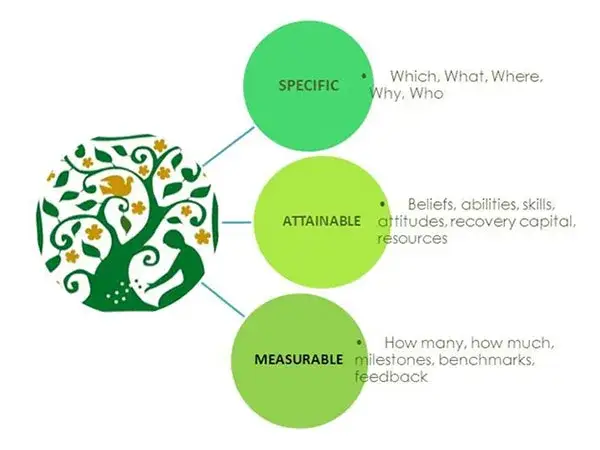PEER SUPPORT
Goal-setting is a powerful tool in recovery. The S.A.M. goal setting model is a shorter version of SMART goals. This brief tutorial will teach you why it’s important to make your growth goals Specific, Attainable and Measurable (SAM), and give you an opportunity to practice setting a SAM goal. As you read, you will notice prompts to set SAM goals. Get in the habit of using this model and you will be able to identify, reach and track your accomplishments.
Many people use SMART goals to help them in goal-setting. SMART stands for Specific, Measurable, Attainable, Relevant and Time-Specific. We’ve shortened this tool to three parts. SAM stands for Specific, Attainable and Measurable. We left out Relevant—because we’re assuming you would not set a goal around something that wasn’t relevant to you, and Time-Specific falls under the Measurable category.
Specific
The first part of this guide is about being specific in your goal setting. So, what does it mean to be specific when setting a goal? Here are a couple examples illustrating the difference between a non-specific goal and a goal that is specific:
- A non-specific goal would be “I want to improve my fitness level.” It would be hard to judge progress and to measure this goal because it’s too broad.
- A more specific exercise goal would be “I want to be able to complete the weight circuit at my gym.” This is much more specific and progress around this goal will be easier to assess.
Here are some questions to help you when coming up with a specific goal:
- What exactly do I want to accomplish?
- What will it look like when I reach my goal?
- What is different in my life once I reach this goal? Imagine that you wake up one morning and you have reached your goal. As you look around, identify what is different in your life.
Practice writing a specific goal. Pick one goal you’d like to achieve, and make it as SPECIFIC as possible.
Attainable
The word attainable means “having the ability to accomplish or achieve something.” When setting our goals, it’s important (especially in early sobriety) that we make sure our goals are attainable. Here are examples of an unattainable and attainable goal:
- An unattainable way of stating an exercise goal might be “I want to complete the heaviest weight circuit right away.” That is probably not attainable because it’s very unrealistic to assume you will be able to lift the heaviest weights right off the bat.
- An attainable goal instead might be “I want to start with the beginner weight circuit and get guidance from a trainer to tell me when I’m ready to move up.” This is a specific and more attainable goal.
Here are questions to ask yourself when creating an attainable goal:
- Is this goal reasonably possible?
- Are there any barriers or risks that might get in the way of attaining the goal?
- What positive recovery capital or strengths do I have that will help me reach it?
Practice writing an attainable version of your goal. Write your goal in ATTAINABLE terms.
Measurable
Finally, why should a goal be measurable? Once you’ve written a specific and attainable goal, you need to make sure you can measure the success of your goal and be able to cross it off a list. Here are examples of what unmeasurable and measurable goals look like:
- An unmeasurable version of this exercise goal might be “I will start on the circuit sometime this month and end that when I feel stronger.” There is no tracking here, and nothing specific to measure.
- Instead, a measurable goal would be “I will put my workout on my calendar, start the weight circuit training on the 1st of next month, choose the level that’s appropriate for me, and work out with trainer guidance for 30 days. At the end of that time, I will evaluate my progress and set new goals.”
Here are questions to help you create a measurable goal:
- When will I begin and when will I reach the goal?
- How will I quantify my goal so I’ll know when I’ve reached it? (numerical or time goals, quality of life ratings, frequent feedback from others)
- What tools will I use to track my progress? (calendars, digital tracking, rating or scaling tools, input from an expert, feedback from family or peers, and assessments)
Practice writing a goal that you can clearly measure. Write your goal in MEASURABLE terms.

